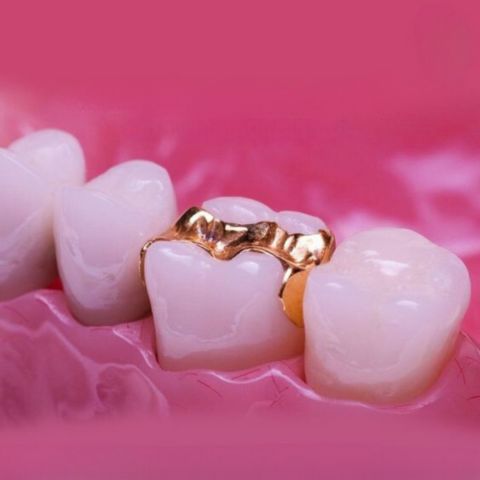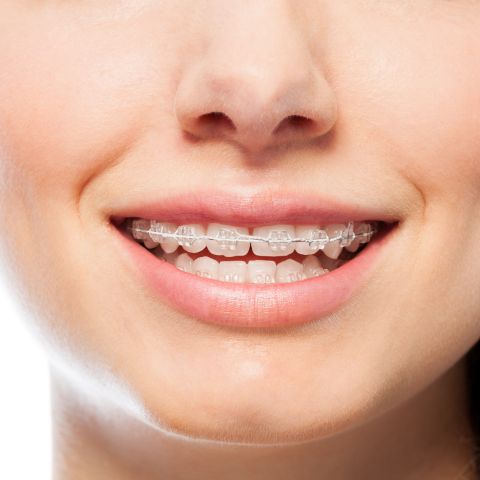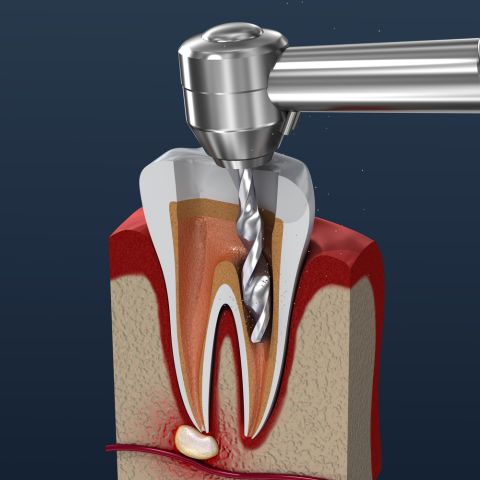

Dental inlays and onlays are both restorative treatments used to repair damaged teeth, but they differ in the extent of the tooth surface they cover. Dental inlays are typically used when the damage is confined within the cusps or biting surface of the tooth, whereas onlays, also referred to as partial crowns, are used when the damage extends beyond one or more cusps.
Both dental inlays and onlays can be made from a variety of materials, such as porcelain, ceramic, composite resin, and gold. Porcelain onlays and ceramic inlays are popular choices for their natural appearance and ability to match the color of the surrounding teeth. Onlay tooth restorations using porcelain or ceramic can provide a highly esthetic result, making them ideal for visible teeth.
Dental onlay and inlay dental treatments can also be crafted from composite resin, which offers a more affordable option compared to porcelain or ceramic, while still maintaining a natural appearance. Tooth inlay and onlay composite restorations are tooth-colored and can be easily shaped and polished for a seamless fit.
Gold onlays are another option for those seeking a highly durable material. While not as aesthetically pleasing as porcelain or composite materials, gold onlays are known for their longevity and strength, making them an excellent choice for restoring teeth that are subjected to heavy biting forces, such as molars.
Inlay and onlay restorations offer a middle ground between dental fillings and dental crowns, addressing tooth damage that is more extensive than what a filling can repair, but not severe enough to require a full crown. Here's how they compare:
- Dental Fillings: These are the most conservative option for restoring a damaged tooth, typically used to treat small cavities or minor tooth decay. Dental fillings can be made from materials such as composite resin, amalgam, or glass ionomer. While fillings are less invasive than inlays, onlays, or crowns, they may not provide sufficient support for larger areas of damage or for teeth subjected to heavy biting forces.
- Inlay Dental Restorations: Inlays are used to repair the damage that is confined within the cusps or biting surface of the tooth. They can be made from materials like porcelain, ceramic, composite resin, and gold. Tooth inlay restorations provide more strength and support than fillings while preserving more of the natural tooth structure compared to onlays or crowns.
- Onlay Tooth Restorations: Dental onlays are suitable for damage that extends beyond one or more cusps of the tooth. Similar to inlays, onlays can be made from porcelain, ceramic, composite resin, or gold. Onlay composite and porcelain onlay restorations offer a natural appearance, while gold onlays provide exceptional durability. Onlays provide additional support compared to inlays but are less invasive than dental crowns.
- Dental Crowns: A dental crown is a full-coverage restoration that encases the entire visible portion of the tooth. Crowns are typically recommended when a tooth is significantly damaged, weakened, or requires a root canal treatment. While dental crowns offer the most comprehensive support and protection, they also require the most extensive tooth reduction, potentially removing more healthy tooth structures than inlays or onlays.
Inlay and onlay restorations can have a significant impact on the appearance and durability of a restored tooth, offering a balance between aesthetics and strength. The choice of material used for inlays and onlays, such as porcelain, ceramic, composite resin, or gold, influences both the appearance and durability of the restoration.
- Appearance: Inlay dental and onlay tooth restorations made from porcelain or ceramic offer a natural appearance and can be color-matched to the surrounding teeth, providing an aesthetically pleasing result. Tooth inlay and onlay composite restorations are also tooth-colored and can be easily shaped and polished for a seamless fit. While gold onlays may not be as visually appealing as porcelain or composite materials, they can be an ideal choice for restoring teeth in areas that are not highly visible, such as molars.
- Durability: The materials used for inlay and onlay restorations greatly influence their longevity and strength. Gold onlays are known for their exceptional durability and ability to withstand heavy biting forces, making them suitable for restoring teeth subjected to significant stress. Porcelain onlays and ceramic inlays are also highly durable and resistant to wear, though not as strong as gold. Onlay composite and tooth inlay restorations made from composite resin may not be as durable as porcelain or gold, but they still provide a strong and long-lasting solution for many patients.
The treatment process for inlay and onlay restorations typically takes two appointments. During the first visit, your dentist will prepare the tooth, remove any decay or damage, and take an impression to create a custom-fit inlay or onlay from materials like porcelain, ceramic, composite resin, or gold. A temporary restoration may be placed to protect the tooth until the next appointment.
The second visit involves removing the temporary restoration, ensuring the fit and bite of the custom inlay or onlay, and then bonding it to the tooth. The entire process usually spans a few weeks, allowing time for the dental laboratory to fabricate the restoration.
There are several instructions that patients should follow:
Before the treatment:
- Maintain good oral hygiene: Ensure that you brush and floss regularly leading up to your appointment to minimize the risk of infection or complications during the procedure.
- Discuss any concerns: If you have any concerns or questions about the inlay or onlay treatment, such as the choice of materials (porcelain, ceramic, composite resin, or gold), be sure to discuss them with your dentist beforehand.
- Inform your dentist of any medical conditions or medications: Share your medical history and any medications you are currently taking with your dentist, as some conditions or medications may affect the treatment or recovery process.
After the treatment:
- Practice proper oral hygiene: Continue to brush and floss regularly to maintain the health and longevity of your inlay or onlay restoration, as well as the surrounding teeth and gums.
- Avoid hard or sticky foods: For the first few days after the procedure, avoid eating hard or sticky foods that may dislodge or damage the restoration.
- Manage pain or discomfort: If you experience any pain or discomfort after the treatment, use over-the-counter pain relievers as advised by your dentist and apply a cold compress to the affected area to help alleviate any swelling.
- Monitor for complications: While complications are rare, keep an eye out for any signs of infection, excessive swelling, or discomfort. If you notice any unusual symptoms, contact your dentist immediately.
- Attend follow-up appointments: It is essential to attend any scheduled follow-up appointments with your dentist to ensure the proper healing and functioning of your inlay or onlay restoration.
Inlay and onlay restorations offer several advantages and some drawbacks, which should be considered when deciding on the most appropriate dental treatment. Here are the pros and cons of inlay dental and onlay tooth restorations:
Pros:
- Preservation of tooth structure: Inlays and onlays are less invasive compared to dental crowns, allowing for the preservation of a more natural tooth structure.
- Aesthetics: Porcelain, ceramic, and composite resin materials used for tooth inlay and onlay composite restorations provide a natural appearance, blending seamlessly with the surrounding teeth.
- Durability: Inlay and onlay restorations made from porcelain, ceramic, or gold are highly durable, with the potential to last for many years with proper care.
- Improved oral health: Inlays and onlays restore the strength and function of damaged teeth, preventing further damage and deterioration, and ultimately supporting overall oral health.
Cons:
- Cost: Inlay and onlay restorations can be more expensive than traditional dental fillings, especially when using high-quality materials like porcelain or gold.
- Multiple appointments: The treatment process typically requires two appointments, spanning a few weeks to allow the dental laboratory to fabricate the custom restoration.
- Potential complications: As with any dental treatment, there is a possibility of risks or complications, such as tooth sensitivity, inaccurate fit, restoration failure, or infection.
In Turkey, dental treatments, including inlay and onlay restorations, are generally more affordable than in the UK and the USA. You can expect to pay approximately $200 to $500 per inlay or onlay restoration in Turkey, depending on the material used and the specific clinic.
In the UK, the cost of inlay and onlay restorations may range from £400 to £800 per tooth, while in the USA, the prices can range from $650 to $1,200 per tooth. These costs are only estimates and can vary based on individual circumstances and the dental practice.
It is essential to note that the lower cost of dental treatments in Turkey, including inlays and onlays, does not necessarily indicate a compromise in quality. Many dental clinics in Turkey, are equipped with state-of-the-art facilities and staffed by highly skilled professionals. This makes Turkey an attractive destination for dental tourism, as patients can benefit from significant cost savings without sacrificing the quality of care.
Choosing Elara as a medical tourism agency for your inlay or onlay restoration treatment comes with numerous benefits that ensure a seamless and comfortable experience. Located in Izmir, Turkey, Elara offers affordable dental treatments compared to other cities, making it an attractive destination for patients seeking high-quality care without breaking the bank.
1. Comprehensive Services: We offer all-inclusive services for medical tourists, covering every aspect of your dental journey. From arranging travel and accommodations to providing assistance with local transportation and coordinating appointments, our agency takes care of every detail to make your trip hassle-free.
2. Multilingual Support: As a multilingual agency, our staff can communicate effectively with patients from various countries and backgrounds, ensuring that your needs are fully understood and addressed throughout your dental treatment process.
3. High-Quality Dental Care: We collaborate with top dental clinics and professionals in Turkey, ensuring that you receive the best possible care. Our partner clinics are equipped with state-of-the-art facilities and staffed by highly skilled dentists who are experienced in performing inlay and onlay restorations.
4. Personalized Experience: Here we understand that each patient has unique needs and preferences. Our team works closely with you to create a tailored treatment plan that addresses your specific dental concerns and aligns with your budget and schedule.



